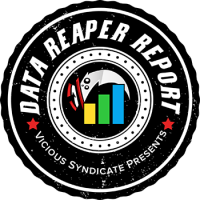
Welcome to the 196th edition of the Data Reaper Report!
Contributing to the Data Reaper project through Hearthstone Deck Tracker or Firestone allows us to perform our analyses and to issue the weekly reports, so we want to wholeheartedly thank our contributors. Without the community’s contributions, there would be no project. Contributing data is very easy, so if you enjoy our content and would like to make sure it remains consistent and free – Sign up!
Quick Links
Class/Archetype Distribution | Class Frequency | Matchup Winrates | vS Power Rankings | vS Meta Score | Class Analysis & Decklists | Meta Breaker of the Week | How to Contribute | Credits
Number of Games
| Overall | 200,000 |
| Top 1K Legend | 7,000 |
| Legend (Excluding Top 1k) | 29,000 |
| Diamond 4 to 1 | 40,000 |
| Diamond 10 to 5 | 45,000 |
| Platinum | 27,000 |
| Bronze/Silver/Gold | 52,000 |
Class/Archetype Distribution
[TABS_PRO id=47446]
Class Frequency
[TABS_PRO id=47447]
Class Frequency Discussion
Initially falling in play in response to the nerfs, Paladin is already in the process of recovering to a similar play rate it exhibited before the balance changes. However, the class is shaping up to be completely different compared to the pre-patch meta. Libram Paladin, previously a fringe deck, is now looking like the most dominant Paladin archetype at higher levels of play. Secret Paladin is in the process of splitting into two distinct variants, the pre-patch iteration, and a new N’Zoth iteration. Aggro Paladin is fading away from existence.
As one of the most established classes before the patch, Rogue might be considered the one least affected by balance changes. This has resulted in an increase in its popularity at higher levels of play. Miracle Rogue’s presence dramatically rises at top legend, where it’s now the most popular deck in the format. It’s followed by a moderate number of Poison Rogues and a small number of Secret Rogues.
Much like Rogue, Priest’s play rate increases as you climb ladder, with Control Priest looking like one of the most influential decks at top legend, where the presence of Warlocks is low. Control Priest remains highly diverse in its builds, with a new list popping out literally every day. Miracle Priest is still around, while Corrupt Priest is seeing new experimentations following the buff to Xanesh.
Demon Hunter is a class that was largely expected to benefit from Paladin nerfs. Judging by its play rate, things are going well for the class. Already exhibiting potential before the patch, Deathrattle Demon Hunter has become a prominent meta contender, taking advantage of buffs to Razorboar and N’Zoth. The deck is still new and highly experimental. At top legend, we also see the prominent return of Lifesteal Demon Hunter to serious meta presence.
Though Spell Mage is still fairly popular throughout ladder, the deck did decline in play compared to its pre-patch play rate. Its numbers at top legend dropped the most and were cut by a half. We’ll have to see whether the nerf to Refreshing Spring Water affected its performance, as many players were expecting to see Incanter’s Flow nerfed instead.
Druid expectedly rose in play, with Gibberling Druid leading the charge, looking to punish a meta that’s becoming increasingly greedy. Clown Druid is another deck that was anticipated to benefit from Paladin nerfs and shines in a slower meta, so we see some awakening experiments there.
The buff to Shieldmaiden has awakened the sleeping Control Warrior into a more significant presence in the meta. C’Thun is seeing a near 100% inclusion rate in this archetype, followed by sporadic appearances of Rattlegore. Rush Warrior looks unchanged and is fairly noticeable throughout ladder.
The nerf to Hysteria did not affect the play rate of Priest, nor did it affect Warlock. While we do see a slightly lower number of Control Warlocks, the archetype is still quite popular outside of top legend. Other than the meme-tastic Mill Warlock, there are some Demon Warlocks experimenting with Deck of Chaos as well as Zoo Warlocks trying out Fiendish Circle.
Face Hunter exhibits the same play rate pattern we’re used to. Popular at lower ranks, rises in play as you climb ladder until it peaks at the high Diamond bracket, before declining at legend and fading into a small presence at top legend.
Shaman still looks dead. There’s some interest in Elemental Shaman following the buff to Lilypad Lurker, but it doesn’t seem like much has changed. Has it?
[TABS_PRO id=47448]

[TABS_PRO id=47449]
vS Meta Score
[TABS_PRO id=47450]
vS Power Rankings Discussion
There seems to be a sentiment that the balance patch failed to change anything about the meta. Other than the fact that a Paladin deck is at the top of the meta, we don’t see how things haven’t changed. There’s a lot to go through, and a lot of details that should convince you that we’re entering a different meta, but with familiar faces.
- Paladin
- After looking fairly strong but being considered an afterthought pre-patch, Libram Paladin is establishing itself as the strongest deck in the game. Benefiting from the Crabrider nerf and employing a very different game plan from Secret Paladin, the deck’s matchup spread looks extremely well rounded.
- While Secret Paladin was hit by balance changes, the field has become more favorable to it with players commonly running decks that fall prey to it. Secret Paladin is very effective at punishing inefficiency, so its win rate stayed high despite being weaker in a vacuum.
- But this isn’t the entire story. There is room to grow for the archetype and the depth of cards at its disposal was further boosted by the buff to N’Zoth, offering Secret Paladin a different late-game approach that looks very successful. It potentially has a higher ceiling than the standard pre-patch iteration that was hit by the Crabrider nerf. What’s important to understand is that Secret Paladin is becoming greedier, and is no longer a dominant early game menace that destroys aggressive decks. At the end of its development, we’re likely to find a vastly different deck with a vastly different matchup spread and real weaknesses.
- And then Aggro Paladin is likely just gone from the format. It’s the deck that has the most difficulty adjusting to the Crabrider nerf, and though its win rate isn’t bad, it’s completely outclassed by Secret Paladin which makes it hard to justify playing it. It’s been made redundant.
- The bottom line is that the balance changes were successful in curbing Paladin’s early game dominance, removing Crabrider/First Day/Hand of A’dal blowout games where there was a serious lack of player agency. Yet, Paladin’s ongoing success comes down to a deep, synergistic card pool. The game is being set up for a mini-set, where other classes will hopefully receive the tools to compete on a more even footing with the Libram/Secret packages.
- Rogue
- Miracle Rogue’s win rate correlates with its play rate, as it exhibits gradually stronger performance at higher levels of play. Its matchup spread is very balanced, giving the pilot the feeling that every matchup is ‘winnable’. That seems to carry some psychological value beyond its overall win rate.
- Secret Rogue isn’t as balanced and tends to specialize in some matchups (Paladin) while doing worse in others. This gives it an edge where Paladin is very popular but makes it worse at top legend.
- Poison Rogue isn’t the meta force it might have been if Paladin didn’t recover as impressively as it did. The shift in Paladin’s identity is not doing much for Poison Rogue’s standing in the meta either, as it still greatly struggles against slower Paladin decks.
- Priest
- Not much has changed for Control Priest. Largely unplayable where Warlocks are prevalent, and largely influential where they aren’t. It also helps that Control Priest significantly improves many of its matchups at top legend. It’s an impressively complex deck.
- Miracle Priest is another very complex deck, but its power level is just not there. Its performance looked pretty decent early on, but nosedived as the meta gradually became more efficient.
- Corrupt Priest… there might be something here! It may not be overly powerful but the buff to Xanesh has sparked some experimentation and we’ve identified something that could be respectable. The key is not overcommitting to an entirely new archetype but relying on a Control Priest defensive shell to carry its weight.
- Demon Hunter
- Deathrattle Demon Hunter has emerged into the scene with an extremely threat-dense build that dominates removal-focused control decks but falls prey to faster opponents that can outpace it. The archetype tends to beat inefficent jank, which is not a good look to its future prospects even though its current win rate is fairly strong. Its performance is taking a sharp decline at top legend and may reach sub-50% territory very soon. We think there’s a solution to its current issues, and by reducing some of its greed, it could stand the test of time.
- Lifesteal Demon Hunter looks much better in the current meta. Though it still isn’t particularly dominant and faces similar struggles against slower Paladin builds, it’s far more competitive and many fans of the deck can now pilot it at higher levels and not feel hamstrung.
- Mage
- The change in Spell Mage’s performance is something that can only be truly appreciated with data, and is very difficult to spot as an individual queuing up games on ladder. The number of matchups that have gotten worse for Spell Mage as a result of the nerf to Spring Water is incredible. The deck is just weaker across the board, and the result is a win rate that fails to come close to the 50% mark at any level of play. At this point, it’s clear that Spell Mage is largely overplayed and the psychological impact of Incanter’s Flow is making the deck feel stronger than it actually is.
- Druid
- The meta is also smiling upon Malfurion. Gibberling Druid is highly punishing to deal with if you’re playing a bunch of inefficient cards, but the stronger standing into Secret Paladin in the aftermath of the nerf to Crabrider and the archetype’s likely direction is encouraging. The deck should face a more hostile meta as things settle down, but will remain relevant and competitive.
- What the class may have gained is another viable and competitive archetype in Clown Druid. Always on the fringes of the meta before the patch, Clown Druid now looks like a serious threat. Its standing against Paladin is dramatically better thanks to the Crabrider nerf (that card was a huge pain for Druid on turn 2), and it’s a different answer to the meta’s greed. Try to outgreed 4 waves of Carnival Clowns!
- Warrior
- Rush Warrior is still strong and very well-rounded. It’s the best answer available to Miracle Rogue, which is why it performs so well at higher levels even though Priest is common. Its standing against Paladin could get worse with the rise of Libram Paladin and Secret Paladin’s shift into N’Zoth builds. But overall, Rush Warrior doesn’t have overly bad matchups, which makes it a fairly reliable ladder climber.
- Control Warrior’s situation is very interesting. The deck has gotten significantly stronger thanks to the Shieldmaiden buff, though still seems far away from being consistently strong due to an extremely polarizing matchup spread with some very oppressive opponents. But, the deck has room to improve with one very simple trick, which would make it less one-dimensional (Warrior section). Its strong matchups into hyper-aggressive decks, and decent matchups into Miracle Rogue and Control Priest, keep it on the fringes of viability at top legend.
- Warlock
- Tickatus may have dodged the bullet, but Control Warlock remains very weak and unimpressive. Team 5 may have decided that there is more value in letting people enjoy playing this bad deck, than removing it in order to address the complaints.
- Hunter
- Face Hunter’s doing well in punishing the inefficient early patch meta. But, things could quickly get worse for the archetype with several of its counters looking very impressive and likely to rise in play, spearheaded by Libram Paladin. The deck’s win rate will likely decline to a decent, but harmless spot not very different from where it’s been throughout this expansion. The good news for Face Hunter is that Secret Paladin is no longer a matchup it fears.
- Shaman
- Shaman needs more than a couple of buffs. It needs a new set. Otherwise, it has no chance to compete.
Class Analysis & Decklists
Demon Hunter | Druid | Hunter | Mage | Paladin | Priest | Rogue | Shaman | Warlock | Warrior
Paladin may still look dominant, but the balance changes have completely changed the way the class wants to play the game. Its early game has grown significantly weaker as a result of the Crabrider nerf and the First Day of School rework, and it’s now looking to focus on a stronger late game to compensate for it.
From a fairly fringe choice on ladder, Libram Paladin has become the strongest deck in the format. The nerf to Crabrider has helped its matchups into faster Paladin decks, while the 1-mana First Day of School can be considered a pure sidegrade. The featured build is a slight deviation from the list popularized by BabyBear. Samuro is a great addition to the deck. We think the 2nd Galloping Savior is more valuable than Reckoning (you’re going to feel that in the Rogue matchups). Double Libram of Judgment is massive in multiple late-game matchups. Pen Flinger is not really necessary and there is merit to running two copies of Libram of Justice instead (great in Paladin mirrors and against Priest).
Secret Paladin is still very successful on ladder, and seems to be splitting off into two variants. The Divine Secret build is very similar to the pre-patch iteration of the archetype. Crabrider and Mankrik aren’t worth including anymore, so we opt to run Argent Protector and Goody Two-Shields. The stickiness helps us connect buffs and swing value trades.
The new N’Zoth variant is showing even more promise, with significant scope for improvement. This build sacrifices percentages in faster matchups, but is extremely dominant in the late game, making it a superior choice at higher levels of play with great matchups into decks such as Control Priest and Libram Paladin.
The common build on ladder runs 6 secrets, including 2 copies of Reckoning, no Convictions (!), and Safety Inspector, so we can shuffle drawn secrets back into our deck. This is a backward approach. We should be running Conviction over Reckoning so that our Knight of Anointment becomes insanely powerful. Once we do that, Righteous Protector becomes far more useful than Safety Inspector.
One thing we noticed about the build is how powerful Carousel Gryphon is, but the card can be difficult to consistently corrupt. This is why we add Dragonmaw Sky Stalker as another 6-drop alongside Hammer of the Naaru, and this allows us to run two Redscale Dragontamers with Alexstrasza. Venomous Scorpid is okay but not needed for N’Zoth since Galloping Savior summons a good beast body to resurrect. We’ll see how this deck further develops as it becomes more popular.
Aggro Paladin is likely going to fade away, not necessarily because it’s bad, but it’s significantly weaker than other Paladin decks. It was very reliant on Crabrider, which is why the nerf hit it hardest. The alternative payoff to the buff package is Argent Braggart, but we already know it’s nowhere near as good as Crabrider was.
As one of the more prominent classes that was least affected by the balance changes, Rogue has become very prevalent at higher levels of play, with Miracle Rogue turning into a highly favored deck by many top-level players.
The reason is quite simple. While its win rate isn’t the highest in the format, it’s got many close matchups and a relatively high skill ceiling compared to other decks in the field. This provides a sense of comfort, since every matchup feels winnable. However, Warrior and Priest do represent a consistent problem for the archetype.
Secret Rogue specializes in the Paladin matchups, and also performs better against Priest. This comes at the sacrifice of faster matchups, as well as some matchups where the Rogue needs to pressure and the secret package doesn’t contribute to that plan.
Poison Rogue failed to capitalize on the nerfs to Paladin, since the class is still very strong and dominates Poison Rogue even when its game plan is slower. Libram Paladin is just as crippling of a counter as aggressive Paladin decks. Add Rogue’s longstanding issue with Gibberling Druid and Face Hunter, and you’ve got a highly polarizing deck that’s not a recommended choice throughout most of ladder.
Control Priest is in a similar position to where it was before the balance changes. Very weak outside of top legend, where it becomes a legitimate contender thanks to far fewer Warlocks and other improving matchups at higher levels, though it still tends to be targeted by the field. We continue to recommend the Giants build as it is the most well-rounded list available, with one note regarding the increasing importance of Illucia at top legend due to the prevalence of Miracle Rogue and Lifesteal Demon Hunter.
Many other cards are also experimented with in the archetype. If they’re not included, it means they have more narrow uses that are situationally powerful in some matchups, but can be a liability in others (Onyx Magescribe, Desperate Prayer, The Nameless One, and Condemn are good examples). Control Priest generally sees a lot of experimentation. A new N’Zoth build emerged just over the past couple of days, and we didn’t have a chance to properly evaluate it yet. If it gains further traction and shows promise, we’ll likely discuss it next week.
Miracle Priest looked alright in the first couple of days of the patch, but has been sinking ever since. Paladins are a big problem for the deck.
Corrupt Priest started popping up more frequently following the buff to Xanesh, and there could be something there. We see more promise in a build that keeps the early game development of Control Priest with Wandmaker/Scorpid, as well is its strong swings through both Samuro and Xyrella, but plasters the Corrupt package on top of it. Carnival Clowns offer a very strong win condition that largely outclasses the N’Zoth path.
The balance changes have tremendously benefitted the Demon Hunter class. While Paladin is still very strong and popular, its slower and less aggressive playstyle is far more manageable for an archetype such as Deathrattle Demon Hunter to deal with. This deck has gained a lot of traction following the patch and shows enough promise to likely stick around, though much can be said about its common builds.
The key takeaway is that DRDH is far too greedy on ladder. Unless the meta is exceptionally slow, there is no need to run the amount of value it currently possesses since Inquisitors alongside weapon damage can comfortably win slower matchups. Cards such as N’Zoth, Al’ar, Taelan, Felscreamer, and Berskerer are major liabilities in faster matchups and also weaken your Skull of Gul’dan. We don’t need Blackthorn to summon 5-drops for it to be extremely powerful, and they’re not worth including if they are such weak standalone cards.
The featured list builds around one of the most promising cards in the deck in Felsteel Executioner, and imitates Soul Demon Hunter in its game plan. We focus on attack buffs enabling Bladed Lady, as well as healing through Aldrachi Warblades. Fishy Flyer may not carry the pure stats of Darkspear Berserker, but it has an immediate impact on the board, clears the way to the opponent’s face, and doesn’t kill us. Felsteel Executioner represents a lot of damage, and it’s not difficult to put our opponents low enough for Inquisitors to finish the job. Deathrattle DH’s main weakness is its lack of AOE compared to the old Soul Demon Hunter, which isn’t easy to address unless you run counterproductive cards such as Immolation Aura.
Lifesteal Demon Hunter has also gotten much better, and sits closer to the 50% mark at top legend, though it still struggles against Paladin even when its game plan is slower. Its position in the meta is now more similar to where it was during Darkmoon Faire. The pure combo build is now the way to go, with one suggestion: Ooze is a tech card the deck has always been more comfortable running due to its plethora of card draw, and it could be quite important in the Paladin matchups (Sword, Hammer, Judgment). Add its usefulness against Poison Rogue and Warriors (Bulwark), and Ooze may become worthwhile. Throw Glaive is an option for faster matchups.
Contrary to popular perception, the Spring Water nerf has proven to be a very impactful change to Spell Mage’s performance. Many of its matchups have gotten worse, and the deck no longer exhibits a positive win rate at any rank bracket. It’s even more reliant on drawing Incanter’s Flow than before, and non-Flow games are very sad.
We continue to recommend running double Shooting Star. It’s even better compared to Flamestrike than before the patch since Flamestrike is less useful with Paladin becoming more resilient to board clears. You’d rather have the cheap removal in most matchups, especially against Miracle Rogue, Face Hunter, or Gibberling Druid where Shooting Star is amazing.
New signs of life are seen within the Druid class thanks to the balance changes.
Gibberling Druid is taking advantage of an unsettled meta to springboard near the top of the meta. Though we expect it to drop off to some degree as opponents become more efficient, it should remain a successful and prominent choice. Nothing about the build should be changed, as you want to be as sticky as possible against the current field.
Clown Druid is dramatically better, no longer destroyed by early Crabrider blowouts, the Paladin matchups have become far more tolerable. In addition, slower Paladin decks give the Druid more time to ramp and develop its game plan. You still face an issue against hyper-aggression (Gibberling Druid, Face Hunter), but it’s offset by your dominant slower matchups. Speaking of slower matchups, the increase in their popularity has made Y’Shaarj a reasonable inclusion.
Rush Warrior did not feel the impact of the Crabrider change as much as Paladin, since it didn’t heavily rely on it to be an early blowout tool. Not having the option to develop an early Crabrider threat alongside Parade Leader or Rokara does hurt, but Crabrider was mostly a mid-game swing card in this deck, and it remains so. We did notice that Shield of Honor got worse as a result, so we’ve opted to run Tent Trashers instead.
Control Warrior is showing some signs of life thanks to the Shieldmaiden buff. A 5-mana Shieldmaiden has proven to be quite strong, and we think the impact of this change will be felt more dramatically in the future. Currently, Control Warrior looks like a very polarizing deck that’s quite flawed but has some promise behind its scope for improvement.
The main issue of popular ladder builds is the absence of Rattlegore. There is an over-fixation on the Priest matchup, which is why C’Thun is included, yet Rattlegore is so important in multiple matchups that omitting it should be illegal. Athletic Studies’ early game utility is nowhere near as important as the late game prowess behind the Rattlegore/Faceless/Taelan package. So many matchups turn around thanks to the addition of these cards that we would really like to see it in action in greater numbers.
One novel card that was first introduced by Zyrios is Magtheridon, and we’re quite impressed by its performance in many key matchups. It looks core to the deck.
If there’s one thing the patch did not change, it’s Warlock’s standing in the meta. Control Warlock is still quite weak and there’s not much room for it to grow. A bright red matchup spread dooms it to Tier 4 at most levels of play. We did update the list to perform as best as it can against the current field, but don’t expect any miracles. Twisting Nether should become important against new Paladin builds, and flex spots are split between Ogremancers and Siphon Souls.
Any experiment with Deck of Chaos has proven to be terrible, Zoo Warlock remains unplayable, and we all know how bad Mill Warlock is. The class is a skip.
Face Hunter naturally preys on a young meta, so it’s expected to do well early and then decline as time goes on. This seems to be exactly what’s happening. Hunter started strong by bashing the faces of inefficient and needlessly greedy decks, but once the meta settles down and the strong decks rise to prominence, the field should be far more hostile to Face Hunter. It will still do well enough throughout ladder to be relevant, but it’s not going to dominate. There are too many reliable counters to its game plan.
Other archetypes of the class don’t really exist. Hunter has terrible Year of the Phoenix sets and its current primary archetype is carried by an incredibly well-rounded Barrens set. For us to see other Hunter decks, we’re going to have to get new cards. Balance changes won’t be enough here.
Shaman is still dead. While the buffs to some of its cards could end up making a difference down the road, Shaman’s current issues are beyond saving with its current card pool. The class is desperate for win conditions and for mechanics that put their opponents under real pressure. Thrall has had enough of decent complementary cards. He wants his Shudderwock, his Bloodlust, and his Cram Session. It’s as simple as that.
Paladin might still be the strongest class in the current meta, but the way to play Paladin has drastically changed, and Libram Paladin’s rise to the top is proof. The post-rotation card pool put the class in a position where it was able to soak multiple nerfs and still come out swinging, and one of the most important packages that helps Paladin find this kind of flexibility is the Libram package.
Highly flavorful, defensively resilient while packing a good late-game punch, Librams gave a class that was previously one-dimensional and lost, strong foundations for a deck. It resembles the success Rogue has had with lackeys throughout the Year of the Dragon, which carried over into the next year and solidified its position in the meta.
Shaman can only hope that something similar will arrive at its lap.
Preparing our weekly article requires a significant amount of time and effort from many individuals. We would like to wholeheartedly thank our current Patreons, whose generous donations help us fund computing and server costs.
vS Gold is a new membership plan aimed to support our efforts towards improving our content and data analysis while receiving some bonuses and extra features.
Tier 3+ Patrons
Special thanks to Leo G, Aaron B, Jed M, Drew M, Alan J, Zolstar, Sean H, Steve F, Andrew N, NObdy, Alonso P, James Y, Je-ho, Ziqiao Y, Stephen H, William H, 1RiceBowl1, Alex S, PeejTreon, Josh G, Matthew H, Bruno B, Amir, Matthew P, nmbrthry, amenbrotep, Karhu, Fisherington, Christopher N, Eric F, Eric L, BraveLittleStove, Lime, Fireproofflame, Brandon G, Kaushal. Frizbiz, TGinge, David, Joshua B, John C, Jeff C, Pi, Reharl, Turd F, Eternal, Scott L, Brandon M, Jeff P, Mark P, and Keith C for supporting us this month.
Contributors
Here are all the people that participated in bringing you this edition of the vS Data Reaper Report:































You are correct on your assessment of Clown Druid. The Paladin nerfs helped a bunch. It can beat everything but the Hunters and Gibbering Druid. Paladin was still the most popular class I seen on the push to Legend. But I was able to beat them most of the time now. Clown Druid is able to climb in Legend also.
It’s too bad the Hysteria nerf basically killed Kazakus priest. It was fun while it lasted.